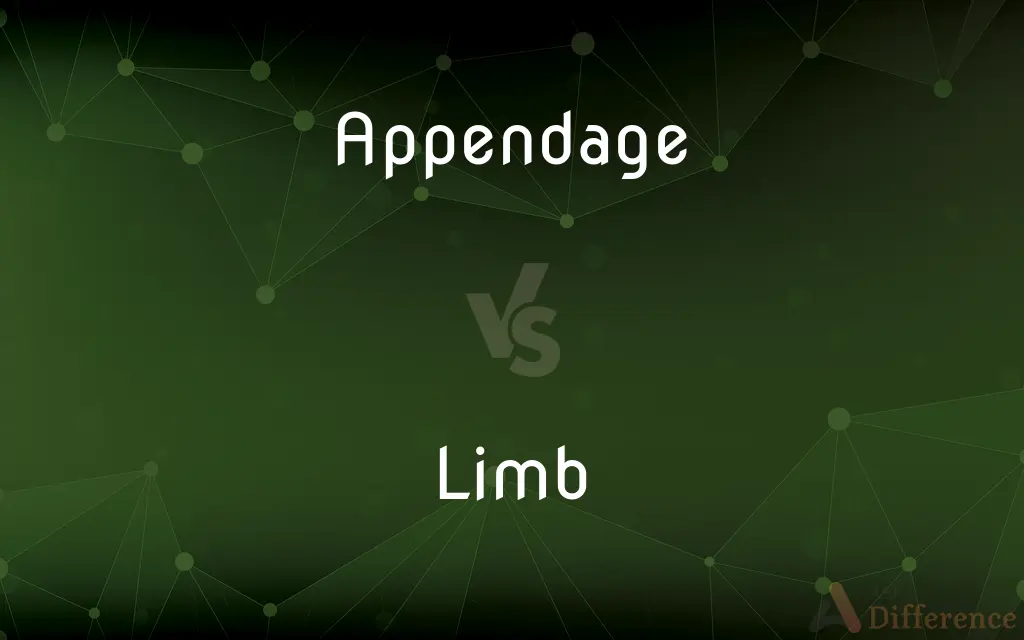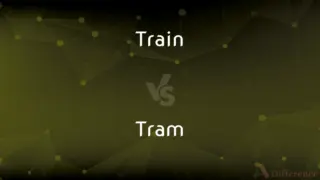Appendage vs. Limb — What's the Difference?
By Maham Liaqat & Urooj Arif — Updated on April 6, 2024
Appendages are structures attached to a body, serving various functions, whereas limbs are specific appendages used for locomotion or manipulation.

Difference Between Appendage and Limb
Table of Contents
ADVERTISEMENT
Key Differences
Appendages encompass a wide range of bodily extensions, including limbs, tails, and antennae, depending on the organism's structure and evolutionary background. These structures can serve various functions such as movement, feeding, or sensory perception. Whereas limbs are a subset of appendages specifically evolved for locomotion (e.g., walking, swimming) or manipulation (e.g., grasping, holding) in many animals, including humans. This distinction highlights the functional specialization of limbs within the broader category of appendages.
Appendages can be found in a variety of organisms across the animal kingdom, from the antennae and pincers of arthropods to the fins of fish and the wings of birds. This diversity reflects the evolutionary adaptability of appendages to different environmental challenges and life strategies. On the other hand, limbs are characteristic of vertebrates, although some invertebrates like cephalopods have limb-like structures (tentacles) that perform similar functions.
The development of appendages is governed by complex genetic and embryological processes, which dictate their form, function, and number. These processes are highly conserved across different species, suggesting a common evolutionary origin for appendages. Whereas the development of limbs, in particular, involves specific genes and developmental pathways that ensure the proper formation of bones, muscles, and joints necessary for their specialized functions.
In terms of functionality, appendages can perform a myriad of roles, including but not limited to locomotion, feeding, defense, and reproduction. For instance, the fins of fish are appendages adapted for swimming, while the mandibles of insects are appendages specialized for feeding. Limbs, however, are primarily associated with movement and manipulation, such as the legs for walking or running and the arms for grasping or lifting.
While all limbs are appendages, not all appendages are limbs. This distinction is crucial for understanding the biological and evolutionary context of these structures. For example, the presence of specific types of limbs, such as wings in birds or arms in primates, can provide insights into the lifestyle and capabilities of the organism, whereas the broader category of appendages reveals the fundamental architectural and functional diversity in the animal kingdom.
ADVERTISEMENT
Comparison Chart
Definition
An external body part or projection, not specific in function.
A specific type of appendage used for locomotion or manipulation.
Types
Antennae, fins, tails, wings, pincers.
Arms, legs, wings, flippers.
Function
Varies widely: sensory, locomotion, manipulation, feeding.
Primarily locomotion or manipulation.
Presence
Across many animal groups, including invertebrates and vertebrates.
Mainly in vertebrates, though some invertebrates have limb-like structures.
Evolutionary significance
Reflects adaptability to different environments and roles.
Indicates specialization for specific functions, like movement.
Compare with Definitions
Appendage
Any external body part that extends from the main structure.
The octopus's appendages allow it to grasp objects and sense its environment.
Limb
Characterized by being jointed and usually having muscles and bones.
Human limbs are capable of complex movements due to their muscular and skeletal structure.
Appendage
Not specific to function or form; can include various structures.
Insects have appendages that serve as sensory organs and for locomotion.
Limb
Includes arms, legs, wings, and flippers among vertebrates.
The kangaroo uses its powerful hind limbs for jumping.
Appendage
Present in both invertebrates and vertebrates.
Fish use their appendages, like fins, for swimming.
Limb
Primarily found in vertebrates, though some invertebrates have analogous structures.
Octopuses have limb-like tentacles used for moving and manipulating objects.
Appendage
Can be specialized or modified according to the organism's needs.
The peacock's tail feathers are colorful appendages used in mating displays.
Limb
A specialized appendage used for movement or manipulation.
Birds use their limbs (wings) for flying.
Appendage
Reflects a broad concept of external body parts.
The crab's pincers are appendages used for feeding and defense.
Limb
Evolved specifically for locomotion or handling objects.
The elephant uses its limbs (legs) for walking and its limb (trunk) for grasping.
Appendage
Something added or attached to an entity of greater importance or size; an adjunct.
Limb
One of the larger branches of a tree.
Appendage
(Biology) A part or organ, such as an arm, leg, tail, or fin, that is joined to the axis or trunk of a body.
Limb
One of the jointed appendages of an animal, such as an arm, leg, wing, or flipper, used for locomotion or grasping.
Appendage
An external body part that projects from the body.
Limb
An extension or a projecting part, as of a building or mountain range.
Appendage
A natural prolongation or projection from a part of any organism.
Limb
An extension or part distinguished from the main body or group
The conservative limb of the party.
Appendage
A part that is joined to something larger.
Limb
A member or representative of a group
Was arrested by a burly limb of the law.
Appendage
Something appended to, or accompanying, a principal or greater thing, though not necessary to it, as a portico to a house.
Modesty is the appendage of sobriety.
Limb
(Archaic)An impish child.
Appendage
A subordinate or subsidiary part or organ; an external organ or limb, esp. of the articulates.
Antennæ and other appendages used for feeling.
Limb
(Astronomy)The circumferential edge of the apparent disk of a celestial body.
Appendage
An external body part that projects from the body;
It is important to keep the extremities warm
Limb
(Mathematics)The edge of a graduated arc or circle used in an instrument to measure angles.
Appendage
A natural prolongation or projection from a part of an organism either animal or plant;
A bony process
Limb
(Botany)The expanded tip of a plant organ, such as a petal or corolla lobe.
Appendage
A part that is joined to something larger
Limb
To remove the branches from.
Limb
A major appendage of human or animal, used for locomotion (such as an arm, leg or wing).
Limb
A branch of a tree.
Limb
(archery) The part of the bow, from the handle to the tip.
Limb
An elementary piece of the mechanism of a lock.
Limb
A thing or person regarded as a part or member of, or attachment to, something else.
Limb
(astronomy) The apparent visual edge of a celestial body.
The solar limb
Limb
(on a measuring instrument) The graduated edge of a circle or arc.
Limb
(botany) The border or upper spreading part of a monopetalous corolla, or of a petal or sepal; blade.
Limb
(transitive) To remove the limbs from (an animal or tree).
They limbed the felled trees before cutting them into logs.
Limb
(transitive) To supply with limbs.
Limb
A part of a tree which extends from the trunk and separates into branches and twigs; a large branch.
Limb
An arm or a leg of a human being; a leg, arm, or wing of an animal.
A second Hector for his grim aspect,And large proportion of his strong-knit limbs.
Limb
A thing or person regarded as a part or member of, or attachment to, something else.
That little limb of the devil has cheated the gallows.
Limb
An elementary piece of the mechanism of a lock.
Limb
A border or edge, in certain special uses.
Limb
To supply with limbs.
Limb
To dismember; to tear off the limbs of.
Limb
One of the jointed appendages of an animal used for locomotion or grasping: arm; leg; wing; flipper
Limb
Any of the main branches arising from the trunk or a bough of a tree
Limb
(astronomy) the circumferential edge of the apparent disc of the sun or the moon or a planet
Limb
Either of the two halves of a bow from handle to tip;
The upper limb of the bow
Limb
Any projection that is thought to resemble an arm;
The arm of the record player
An arm of the sea
A branch of the sewer
Common Curiosities
Can an appendage be an internal structure?
No, appendages are external projections or extensions from the body.
What makes a limb different from other appendages?
Limbs are specialized for movement or manipulation, characterized by their structure and function.
How do appendages develop in organisms?
Appendages develop through complex genetic and embryological processes influenced by evolutionary history.
Are fins considered limbs or appendages?
Fins are appendages, but they can be considered limb-like in their function for swimming in aquatic organisms.
Can appendages evolve over time?
Yes, appendages can evolve to adapt to new environments or lifestyles, reflecting the organism's evolutionary history.
Are all limbs considered appendages?
Yes, all limbs are a specific type of appendage specialized for locomotion or manipulation.
How are limbs adapted for their specific functions?
Limbs are adapted through the development of specialized structures like joints and muscles for specific movements or tasks.
What defines an appendage?
An appendage is any external body part that projects from the main structure of an organism, not necessarily specialized in function.
Do all animals have appendages?
Most animals have some form of appendages, but the type and function vary widely.
Are wings considered limbs?
Yes, wings are considered limbs adapted for flight in birds and some insects.
Can appendages be lost during an organism's evolution?
Yes, appendages can be reduced or lost if they no longer serve a beneficial function, as seen in some evolutionary lineages.
How do the functions of limbs and other appendages differ?
Limbs are primarily for locomotion and manipulation, while other appendages can have varied functions, including sensory perception and feeding.
Can the same appendage have multiple functions?
Yes, some appendages, like the elephant's trunk, can serve multiple functions such as breathing, grasping, and sensing.
Are there any organisms without appendages?
Yes, some organisms, like certain worms and amoebas, lack distinct external appendages.
Do appendages play a role in an organism's survival?
Yes, appendages can play crucial roles in locomotion, feeding, defense, and reproduction, affecting survival and fitness.
Share Your Discovery

Previous Comparison
Mungrel vs. Mongrel
Next Comparison
Train vs. TramAuthor Spotlight
Written by
Maham LiaqatCo-written by
Urooj ArifUrooj is a skilled content writer at Ask Difference, known for her exceptional ability to simplify complex topics into engaging and informative content. With a passion for research and a flair for clear, concise writing, she consistently delivers articles that resonate with our diverse audience.














































